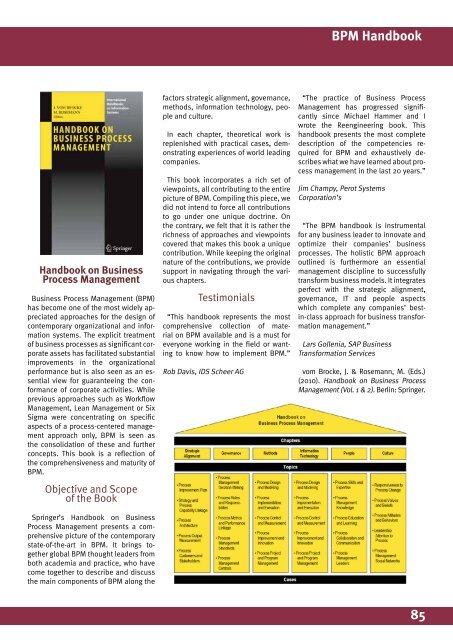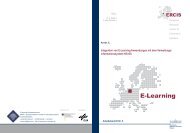2010 - ERCIS
2010 - ERCIS
2010 - ERCIS
You also want an ePaper? Increase the reach of your titles
YUMPU automatically turns print PDFs into web optimized ePapers that Google loves.
Handbook on Business<br />
Process Management<br />
Business Process Management (BPM)<br />
has become one of the most widely appreciated<br />
approaches for the design of<br />
contemporary organizational and information<br />
systems. The explicit treatment<br />
of business processes as significant corporate<br />
assets has facilitated substantial<br />
improvements in the organizational<br />
performance but is also seen as an essential<br />
view for guaranteeing the conformance<br />
of corporate activities. While<br />
previous approaches such as Workflow<br />
Management, Lean Management or Six<br />
Sigma were concentrating on specific<br />
aspects of a process-centered management<br />
approach only, BPM is seen as<br />
the consolidation of these and further<br />
concepts. This book is a reflection of<br />
the comprehensiveness and maturity of<br />
BPM.<br />
Objective and Scope<br />
of the Book<br />
Springer’s Handbook on Business<br />
Process Management presents a comprehensive<br />
picture of the contemporary<br />
state-of-the-art in BPM. It brings together<br />
global BPM thought leaders from<br />
both academia and practice, who have<br />
come together to describe and discuss<br />
the main components of BPM along the<br />
factors strategic alignment, governance,<br />
methods, information technology, people<br />
and culture.<br />
In each chapter, theoretical work is<br />
replenished with practical cases, demonstrating<br />
experiences of world leading<br />
companies.<br />
This book incorporates a rich set of<br />
viewpoints, all contributing to the entire<br />
picture of BPM. Compiling this piece, we<br />
did not intend to force all contributions<br />
to go under one unique doctrine. On<br />
the contrary, we felt that it is rather the<br />
richness of approaches and viewpoints<br />
covered that makes this book a unique<br />
contribution. While keeping the original<br />
nature of the contributions, we provide<br />
support in navigating through the various<br />
chapters.<br />
Testimonials<br />
“This handbook represents the most<br />
comprehensive collection of material<br />
on BPM available and is a must for<br />
everyone working in the field or wanting<br />
to know how to implement BPM.”<br />
Rob Davis, IDS Scheer AG<br />
BPM Handbook<br />
“The practice of Business Process<br />
Management has progressed significantly<br />
since Michael Hammer and I<br />
wrote the Reengineering book. This<br />
handbook presents the most complete<br />
description of the competencies required<br />
for BPM and exhaustively describes<br />
what we have learned about process<br />
management in the last 20 years.”<br />
Jim Champy, Perot Systems<br />
Corporation’s<br />
“The BPM handbook is instrumental<br />
for any business leader to innovate and<br />
optimize their companies’ business<br />
processes. The holistic BPM approach<br />
outlined is furthermore an essential<br />
management discipline to successfully<br />
transform business models. It integrates<br />
perfect with the strategic alignment,<br />
governance, IT and people aspects<br />
which complete any companies’ bestin-class<br />
approach for business transformation<br />
management.”<br />
Lars Gollenia, SAP Business<br />
Transformation Services<br />
vom Brocke, J. & Rosemann, M. (Eds.)<br />
(<strong>2010</strong>). Handbook on Business Process<br />
Management (Vol. 1 & 2). Berlin: Springer.<br />
85














